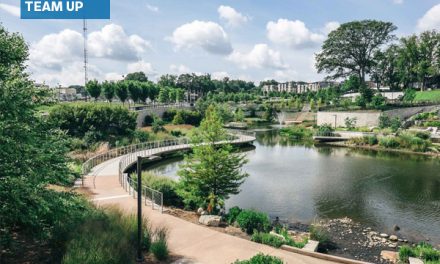Public practice landscape architecture is a not-for-profit enterprise. Its mission is to design, implement, and manage functional, liveable, safe, and attractive places for the public. These spaces are often developed with a larger social goal in mind.
Goals can include:
- Community gathering
- Preservation and acknowledgment of history and place
- Environmental resilience
- Economic vitality
Public practice, including non-profit and governmental work, offers unique opportunities and challenges for practitioners. The ASLA Public Practice Subcommittee encourages more landscape architects to pursue careers in the public sector, especially students in landscape architecture programs and emerging professionals.
Less than ten percent of ASLA’s membership identify as public practitioners. They work for local, state, and federal government agencies, universities and colleges, transit agencies, or parks and arboreta. Many of these ASLA members have found their way to public practice after years in private practice. They seek to have an impact on public spaces for the common good.
For landscape architects, emerging professionals, students, allied professionals, and others who may be less familiar with this type of landscape architecture practice, members of the Public Practice Subcommittee have created an online guide outlining 10 distinctive aspects of public practice work:
- Public Communications
- Contract Administration
- Data Collection & Analysis
- Design
- Engagement
- Project Management
- Public Asset Management
- Regulation & Compliance
- Representation
- Research & Documentation
Explore Public Practice Landscape Architecture >
This resource was created by the Public Practice Subcommittee of the SKILL | ED Practice Management Institute Committee, previously the Public Practice Advisory Committee.
Many thanks to the authors and contributors:
- Jean Senechal Biggs, ASLA, Vice President, Professional Practice
- Adrian Smith, FASLA, Immediate Past Vice President, Professional Practice
- Maureen Colaizzi, ASLA
- Mark Heinicke, ASLA
- Derek Holmer, ASLA
- Bradley Jones, ASLA
- Om Khurjekar, ASLA
- Jill Ochs Zick, ASLA
- Jennifer Shagin, ASLA
- Kris Sorich, ASLA
- Amie Wojtech, ASLA
- Jon Wreschinsky, ASLA
- Bethany Znidersic, ASLA
The Public Practice Subcommittee worked to:
- Increase the number of landscape architects and their level of participation in ASLA from all areas of practice (local, state, and federal government; private; academic; and nonprofit) that are involved in public works of landscape architecture.
- Serve the professional needs and increase the recognition of ASLA members employed in government, nongovernmental organizations, and nonprofit agencies who are involved in public works of landscape architecture.
- Encourage students in landscape architecture programs to pursue careers in the public sector.
Identify and promote opportunities for collaboration among public and private landscape architects. - Increase awareness of the value of built and natural public landscapes.
Looking for even more on public practice?
You may also explore the online resources for ASLA’s Parks and Recreation and Transportation Professional Practice Networks (PPNs), and see these related ASLA Online Learning webinars:
- A Seat at the Table: Landscape Architects in the Public Sector
- Nimble Innovation – Transforming the Public Realm Through Possibility Government
- Nimble Innovation 2.0—The Possibility Government Toolkit in Action
- Inside the LA Studio—MnDOT
- Equitable Transportation Design with Small Communities
For snapshots of public practitioner career paths, check out the Common Space interview series, originally published in ASLA’s LAND newsletter. (Please note: several of these are archived pages, and links may no longer be functional.)
Interviewees include:
Jennifer Shagin, ASLA
Landscape Designer, NES
Kris Sorich, ASLA
Senior Landscape Architect, Chicago Department of Transportation
Haley Blakeman, FASLA, PLA
Suzanne L. Turner Professor at the Robert Reich School of Landscape Architecture at Louisiana State University
Jon Wreschinsky, ASLA, PLA
Facilities Planner, San Diego Unified School District
Terry Clements, FASLA
Professor and Program Chair,
Virginia Tech Landscape Architecture Program
Linda Komes, ASLA
Landscape Architect and Project Manager, Park Development Division, Maryland-National Capital Park and Planning Commission
Nick Aceto
Landscape Architect and Urban Designer, Aceto Landscape Architects
Robynne Heymans, Associate ASLA
Park Planner, Austin Parks and Recreation Department
Theresa Hyslop, Associate ASLA
Project Manager and Landscape Designer, ETM Associates, LLC
Om Khurjekar, ASLA, PLA, LEED AP BD+C
Principal, Hord Coplan Macht
Kevin Meindl, Associate ASLA
Landscape Architect and Green Infrastructure Program Manager, Buffalo Sewer Authority
Darcy Nuffer, ASLA
Landscape Architect, Planning Division, Austin Parks and Recreation Department
Andrea Weber, ASLA
Program Manager for Historic Roadside Properties, Minnesota Department of Transportation (MnDOT)
David T. Tatsumi, ASLA
President, Tatsumi and Partners, Inc.
Nette Compton, ASLA
Deputy Director of Parks for People, The Trust for Public Land
Mark H. Hough, FASLA
University Landscape Architect, Duke University
Mami Hara, ASLA
General Manager and Chief Executive Officer, Seattle Public Utilities
Glenn Acomb, FASLA
Retired from the University of Florida Department of Landscape Architecture and from the Program for Resource Efficient Communities (PREC), a UF cross-disciplinary research group
Dee Merriam, FASLA
Community Planner, Centers for Disease Control and Prevention
Irene Ogata, ASLA
Landscape Architect, City of Tucson, Arizona
And, one more article from the archives for those who’ve made it this far:
The Things They Didn’t Teach You in School About Public Practice
ASLA Public Practice Advisory Committee members look back on what they learned about public practice in school, what they didn’t learn in school but wish they had, and what they think ASLA members should consider before pursuing public practice.




